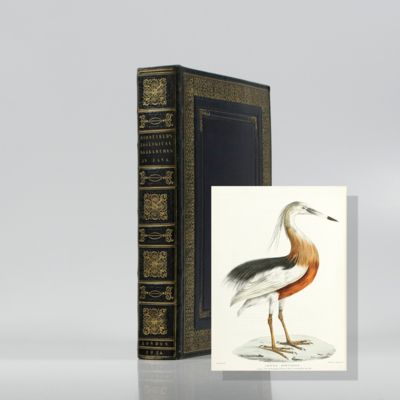Horsfield, T.
Zoological researches in Java and the neighbouring islands.
London, Kinsbury, Parbury & Allan, [1821]-1824. Large 4to (29.4 x 22.8 cm). Title page, dedication leaf, preface (2 pp.), and General Catalogue of Javanese Birds (8 pp.); 72 lithographed plates of which 64 finely hand-coloured, and eight plain, as intended. All with explanatory text leaves and tissue-guarded. Contemporary straight-grained morocco; spine with four broad, flat, raised bands, blind-tooled and with gilt ornaments; compartments with large symmetrical scalloped vignettes; boards with Greek key blind-tooling, broad gilt floral outer border, and inner border with elaborate gilt corners; gilt-rolled edges and inner dentelles; green endpapers. All edges gilt.
A beautifully preserved copy in a fine, richly gilt-ornamented binding, of one of the most important works on the birds and mammals of the Malayan archipelago, in particular Java, but also including Sumatra, and, e.g., Singapore. Several species are described and/or illustrated here for the first time. Thomas Horsfield (1793-1859) was American medical doctor, entomologist and vertebrate zoologist. "In 1799, he accepted a post as surgeon on the vessel China, a merchant vessel that was to sail to Java. He passed through Batavia and was struck by the beauty of the region. In 1801, he applied to be a surgeon with the Dutch Colonial Army in Batavia. Taking up appointment there, he took a keen interest in the flora, fauna, and geology of the region. The East India Company took control of the island from the Dutch in 1811, and Horsfield began to collect plants and animals on behalf of the governor and friend Sir Thomas Stamford Raffles. In 1816, Java was restored to the Dutch and Horsfield moved west to Sumatra. In 1819, he was forced to leave the island due to ill health, and returned to London. On returning to London, Horsfield continued to be in contact with Sir Stamford Raffles and became a keeper of the museum of the East India Company on Leadenhall Street, London, working under Charles Wilkins. He stayed in this position, later as a curator, until his death on July 24, 1859. Horsfield took an interest in geology, botany, zoology, and entomology. He was influenced by William Sharp Macleay and his quinarian system of classification. He was a fellow of the Royal Society of London (1828) and a fellow of the Linnean Society (1820), later becoming a vice president. In 1828, he was elected a member of the American Philosophical Society. Horsfield was appointed assistant secretary of the Zoological Society of London at its formation in 1826. In 1833, he was a founder of what became the Royal Entomological Society of London. He was elected a fellow of the Royal Society in 1828" (Wikipedia). Several species were named after him, including two bats. His zoological research show that he was much interested in bats, as the work contains fine illustrations of many. Also included are several monkeys, cats, and other smaller carnivores, flying squirrels, etc. The majority of animals described, however, are birds. Birds of prey are particularly well-represented. Seven of the eight uncoloured plates show anatomy, mostly skeletons; one shows a rhinoceros. Provenance: on the front pastedown an armorial bookplate of Henry Rogers Broughton, 2nd Baron Fairhaven. His library was one of the grandest natural history libraries in the United Kingdom. Some light offsetting from the plates to opposite text leaves, but generally quite mild. Otherwise near spotless - a rare condition for a work often found much toned and spotted. Bastin and Brommer, 139; Cat. BM(NH) p. 876; Nissen ZBI, 2002; Wood, p. 391.




